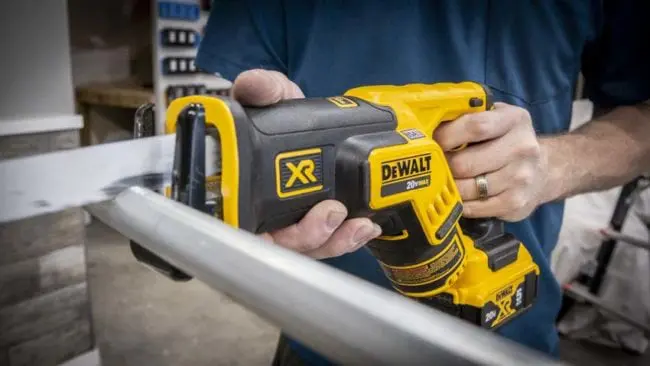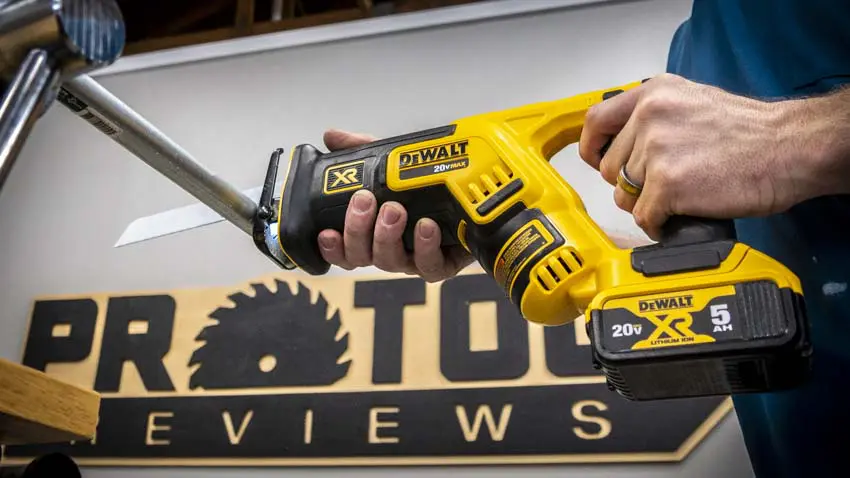DeWalt released the DeWalt DCS367 20V Max brushless compact reciprocating saw (whew, that’s a mouthful!) back in 2017 as a brushless upgrade to its brushed version. As a compact reciprocating saw, it’s a two-handed design rather than the more popular one-handed models such as the Milwaukee M18 Fuel Hackzall.
While it’s a little bulkier than one-hand models, the performance of similar saws tends to be better. We put the DCS367 up against the Makita Sub-Compact Recipro Saw in a battle between the only two professional brands playing in this design space.
Pros
- Faster cutting than Makita’s XRJ07 Sub-Compact Recipro Saw
- Significantly better cutting performance than one-hand compact models
- 4-position blade clamp
- Lever-action blade release
Cons
- Vibration control needs help
- Heaviest in the compact class
DeWalt DCS367 20V Max Brushless Compact Reciprocating Saw Cutting Speed
This compact model specs out pretty well with a no-load speed of 2900 SPM and a stroke length of 1-1/8 inches.
DeWalt topped our charts in cutting speed against all of our compact reciprocating saws. In our nail-embedded wood test (2 x 10 PT with five framing nails), its 16.31-second average was just enough to push Makita (16.40 seconds) to second place.

The closest any of the one-hand saws made it was nearly 2 seconds slower (Kobalt 24V one-handed recip saw) and the group average was a much slower 40+ seconds. On the other hand, the standard cordless reciprocating saws enjoyed a much faster 11-second average.
Switching to 3/4-inch EMT, DeWalt cut at a lightning-fast 1.17-second average. Makita wasn’t far behind at 1.58 seconds. A couple of the one-hand models got close (Kobalt and Ridgid), but the average was a bit higher at 3.63 seconds.

Looking at the overall results, we recommend using the DeWalt DCS367 to cut wood up to 2x, PVC, thin metal, and medium metal. Once you start getting into thicker metals such as rebar or cast iron, you should switch to a more powerful saw.
Vibration Control
One area DeWalt struggles with across its line of reciprocating saws is vibration control. It’s evident in the brushless compact model, scoring just 50 points for vibration control. There may be some change in the air, though. DeWalt’s 20V Max Atomic and 12V brushless one-hand models are excellent in this category.
Feature Set
When you make a compact tool, you often forgo the bells and whistles that your premium tools get. DeWalt is no different and the feature set here is pretty basic, although it’s actually pretty good compared to other compact models.
We already noted that it has a brushless motor. It also includes a pivoting shoe. It doesn’t haven’t an adjustable length, though. There’s also an LED light and a lever-action blade release on the side of the handle that we prefer over a shaft-mounted twist lock.
DeWalt includes its 4-position blade clamp on this model and it’s a great call. This is the kind of saw we turn to in some of the more awkward cutting positions, so having the additional versatility is genuinely helpful.

The only thing Makita includes that DeWalt leaves off is an active blade ejection.
Missing Features
- Orbital action
- Variable speed selection
- Adjustable shoe
- Rafter hook
- Blade ejection
- Smart controls (only found on the Milwaukee M18 Fuel Sawzall with One-Key)
Size and Weight
“Compact” is a relative term for some designs. For DeWalt, it’s really about getting between studs and its 13.3-inch length gets there easily. Makita is a little shorter at 12.4 inches and only three of the one-handed models are shorter. However, those one-hand models aren’t as tall, helping you get into tighter spaces than this.
With the two-hand design, it’s more of a squashed kind of form. The overall length is shorter than a standard model, but it compensates by creating a taller form factor. It’s the price you pay to keep reasonable cutting speeds.
With a 5.0Ah battery, the DeWalt 20V Max brushless compact reciprocating saw is the heaviest in the compact class, including the one-hand models. It’s not obnoxious, though. Makita’s Sub-Compact is only 0.1 pounds lighter with a 5.0Ah pack and you can always save some weight by using 2.0Ah batteries.
Looking up to the standard cordless models, the average weight is 8.4 pounds, giving DeWalt a significant weight improvement compared to those saws. In the end, it absolutely hits the size and weight requirements to be considered a true compact reciprocating saw.
Pricing
You have several options to get your hands on the brushless DeWalt compact reciprocating saw. As a bare tool (DeWalt DCS367B), it’s normally $179. A kit with a 2.0Ah battery (DeWalt DCS367D1) runs $259 and a 5.0Ah kit (DeWalt DCS367P1) will set you back $319. It’s also part of several combo kits.
Makita offers DeWalt’s only major competition in this space and it’s a little less for both the bare tool and kit.
The Bottom Line
The DeWalt DCS367 20V Max brushless compact reciprocating saw is a great option for remodelers, plumbers, HVAC, and electricians that need to cut between studs and want faster cutting performance. A one-hand model is still the best bet for the tightest spaces, but you’ll have to sacrifice speed.
Buy it if you’re looking for the fastest-cutting compact reciprocating saw. Pass if vibration control is a big priority for you.



